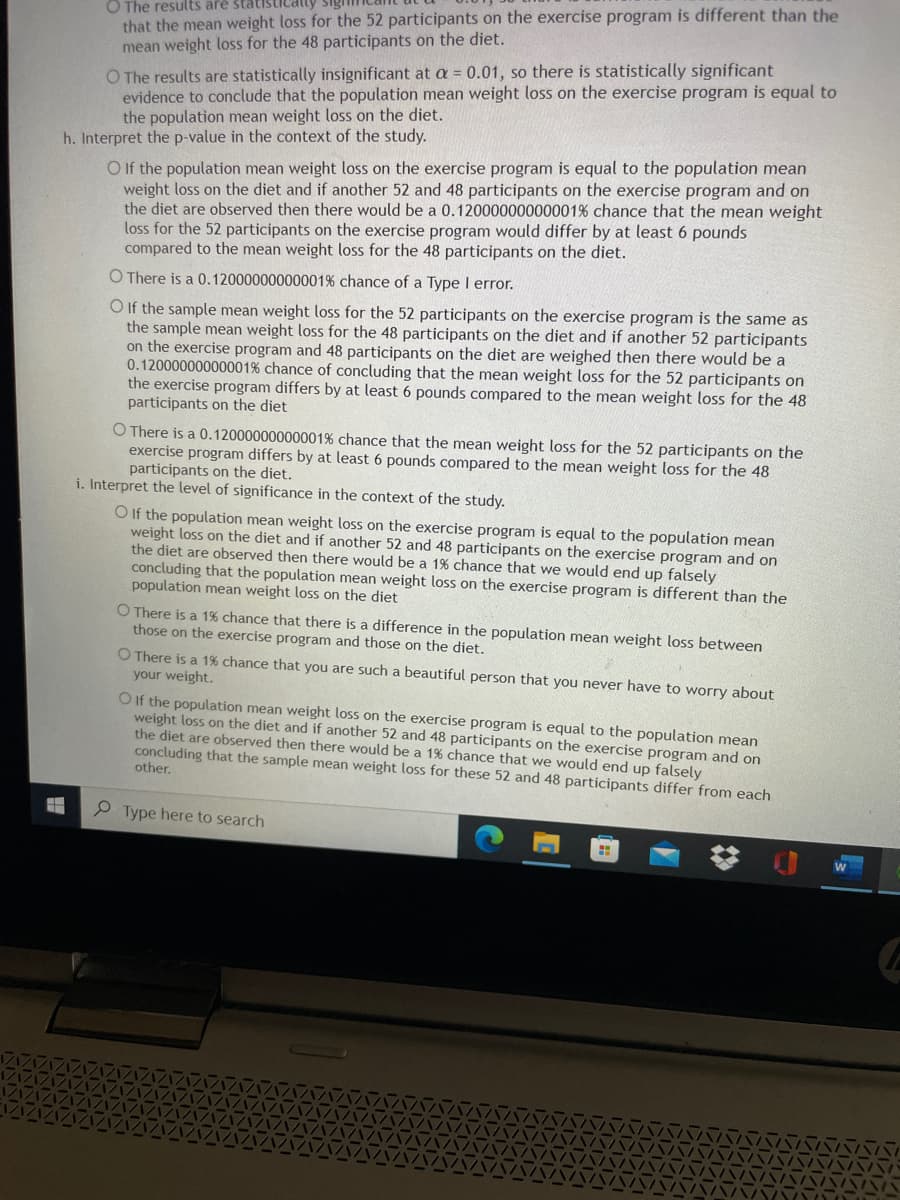Is a weight loss program based on exercise just as effective as a program based on diet? The 52 overweight people put on a strict one year exercise program lost an average of 27 pounds with a standard deviation of 10 pounds. The 48 overweight people put on a strict one year diet lost an average of 21 pounds with a standard deviation of 8 pounds. What can be concluded at the a = 0.01 level of significance?
Is a weight loss program based on exercise just as effective as a program based on diet? The 52 overweight people put on a strict one year exercise program lost an average of 27 pounds with a standard deviation of 10 pounds. The 48 overweight people put on a strict one year diet lost an average of 21 pounds with a standard deviation of 8 pounds. What can be concluded at the a = 0.01 level of significance?
MATLAB: An Introduction with Applications
6th Edition
ISBN:9781119256830
Author:Amos Gilat
Publisher:Amos Gilat
Chapter1: Starting With Matlab
Section: Chapter Questions
Problem 1P
Related questions
Question

Transcribed Image Text:O The results aré štati
that the mean weight loss for the 52 participants on the exercise program is different than the
mean weight loss for the 48 participants on the diet.
O The results are statistically insignificant at a = 0.01, so there is statistically significant
evidence to conclude that the population mean weight loss on the exercise program is equal to
the population mean weight loss on the diet.
h. Interpret the p-value in the context of the study.
O If the population mean weight loss on the exercise program is equal to the population mean
weight loss on the diet and if another 52 and 48 participants on the exercise program and on
the diet are observed then there would be a 0.12000000000001% chance that the mean weight
loss for the 52 participants on the exercise program would differ by at least 6 pounds
compared to the mean weight loss for the 48 participants on the diet.
O There is a 0.12000000000001% chance of a Type I error.
O If the sample mean weight loss for the 52 participants on the exercise program is the same as
the sample mean weight loss for the 48 participants on the diet and if another 52 participants
on the exercise program and 48 participants on the diet are weighed then there would be a
0.12000000000001% chance of concluding that the mean weight loss for the 52 participants on
the exercise program differs by at least 6 pounds compared to the mean weight loss for the 48
participants on the diet
O There is a 0.12000000000001% chance that the mean weight loss for the 52 participants on the
exercise program differs by at least 6 pounds compared to the mean weight loss for the 48
participants on the diet.
i. Interpret the level of significance in the context of the study.
O If the population mean weight loss on the exercise program is equal to the population mean
weight loss on the diet and if another 52 and 48 participants on the exercise program and on
the diet are observed then there would be a 1% chance that we would end up falsely
concluding that the population mean weight loss on the exercise program is different than the
population mean weight loss on the diet
O There is a 1% chance that there is a difference in the population mean weight loss between
those on the exercise program and those on the diet.
O There is a 1% chance that you are such a beautiful person that you never have to worry about
your weight.
O f the population mean weight loss on the exercise program is equal to the population mean
weight loss on the diet and if another 52 and 48 participants on the exercise program and on
the diet are observed then there would be a 1% chance that we would end up falsely
concluding that the sample mean weight loss for these 52 and 48 participants differ from each
other.
P Type here to search

Transcribed Image Text:Is a weight loss program based on exercise just as effective as a program based on diet? The 52 overweight
people put on a strict one year exercise program lost an average of 27 pounds with a standard deviation of
10 pounds. The 48 overweight people put on a strict one year diet lost an average of 21 pounds with a
standard deviation of 8 pounds. What can be concluded at the a = 0.01 level of significance?
%3D
a. For this study, we should use Select an answer
b. The null and alternative hypotheses would be:
Ho: Select an answer v Select an answer v
Select an answer v (please enter a decimal)
H: Select an answer v
Select an answer v
Select an answer v (Please enter a decimal)
c. The test statistic ? v =
(please show your answer to 3 decimal places.)
%3D
d. The p-value =
(Please show your answer to 4 decimal places.)
%3!
e. The p-value is ? v a
f. Based on this, we should Select an answer v the null hypothesis.
g. Thus, the final conclusion is that ...
O The results are statistically insignificant at a = 0.01, so there is insufficient evidence to
conclude that the population mean weight loss on the exercise program is different than the
population mean weight loss on the diet.
%3D
O The results are statistically significant at = 0.01, so there is sufficient evidence to conclude
that the population mean weight loss on the exercise program is different than the population
mean weight loss on the diet.
O The results are statistically significant at a = 0.01, so there is sufficient evidence to conclude
that the mean weight loss for the 52 participants on the exercise program is different than the
mean weight loss for the 48 participants on the diet.
O The results are statistically insignificant at a = 0.01, so there is statistically significant
evidence to conclude that the population mean weight loss on the exercise program is equal to
the population mean weight loss on the diet.
h. Interpret the p-value in the context of the study.
O If the population mean weight loss on the exercise program is equal to the population mean
weight loss on the diet and if another 52 and 48 participants on the exercise program and on
the diet are observed then there would be a 0.12000000000001% chance that the mean weight
loss for the 52 participants on the exercise program would differ by at least 6 pounds
compared to the mean weight loss for the 48 participants on the diet.
O There is a 0.12000000000001% chance of a Type I error.
O If the sample mean weight loss for the 52 participants on the exercise program is the same as
the sample mean weight loss for the 48 participants on the diet and if another 52 participants
nn the exercise prooram and 48 narticinants.on the diet are weighed then there would be a
P Type here to search
bp
Expert Solution
This question has been solved!
Explore an expertly crafted, step-by-step solution for a thorough understanding of key concepts.
Step by step
Solved in 2 steps

Recommended textbooks for you

MATLAB: An Introduction with Applications
Statistics
ISBN:
9781119256830
Author:
Amos Gilat
Publisher:
John Wiley & Sons Inc

Probability and Statistics for Engineering and th…
Statistics
ISBN:
9781305251809
Author:
Jay L. Devore
Publisher:
Cengage Learning

Statistics for The Behavioral Sciences (MindTap C…
Statistics
ISBN:
9781305504912
Author:
Frederick J Gravetter, Larry B. Wallnau
Publisher:
Cengage Learning

MATLAB: An Introduction with Applications
Statistics
ISBN:
9781119256830
Author:
Amos Gilat
Publisher:
John Wiley & Sons Inc

Probability and Statistics for Engineering and th…
Statistics
ISBN:
9781305251809
Author:
Jay L. Devore
Publisher:
Cengage Learning

Statistics for The Behavioral Sciences (MindTap C…
Statistics
ISBN:
9781305504912
Author:
Frederick J Gravetter, Larry B. Wallnau
Publisher:
Cengage Learning

Elementary Statistics: Picturing the World (7th E…
Statistics
ISBN:
9780134683416
Author:
Ron Larson, Betsy Farber
Publisher:
PEARSON

The Basic Practice of Statistics
Statistics
ISBN:
9781319042578
Author:
David S. Moore, William I. Notz, Michael A. Fligner
Publisher:
W. H. Freeman

Introduction to the Practice of Statistics
Statistics
ISBN:
9781319013387
Author:
David S. Moore, George P. McCabe, Bruce A. Craig
Publisher:
W. H. Freeman